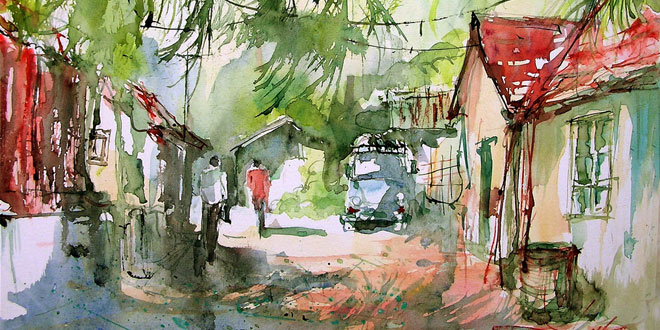Question: You have probably noticed that people in Kalpattu are engaged in a variety of nonfarm work. List five of these.
Answer:
- Making baskets, utensils, pots, bricks bullock-carts etc.
- Teaching
- Washing clothes
- Weaving
- Repairing cycle
Question: List the different types of people you read about in Kalpattu who depend on farming. Who is the poorest among them and why?
Answer: These people are Thulasi, Sekar and Ramalingam. Thulasi is the poorest among them. It is because she has no land of her own. She works on Ramalingam’s field and earns Rs. 40 per day. Although she is not satisfied with her wages, yet she continues her work in Ramalingam’s field because of the fact that she can depend on him.
Question: Imagine you are a member of a fishing family and you are discussing whether to take a loan from the bank for an engine. What would you say?
Answer: I would say that it is better to take a loan from bank for this purpose than to go to a moneylender. Money lenders usually charge high rate of interest which pushes the borrowers in great hardships.
Question: Poor rural labourers like Thulasi often do not have access to good medical facilities, good schools, and other resources. You have read about inequality in the first unit of this text. The difference between her and Ramalingam is one of inequality. Do you think this is a fair situation? What do you think can be done? Discuss in class.
Answer: No, this is not a fair situation. There should be a ceiling of land. It will help everyone to have some land where one can earn one’s livelihood. Opportunity should be equal for all. Primary education should be made compulsory. Efforts should be made to promote education among the poor. It will help them know their rights and other awareness.
Question: What do you think the government can do to help farmers like Sekar when they get into debt? Discuss.
Answer: Government can provide assistance to farmers like Sekar. Interest-free loan or loan at the lowest rate can help him. Seeds, fertilizers and pesticides can also be provided to him on subsidized rate.
Question: Describe different types of work that Sekar do for a living.
Answer: Sekar is a small farmer having only two acres of land. He grows paddy in his field with the help of his family members. He also works in Ramalingam’s rice milk. He helps him collect paddy from other farmers is the neighboring villages. He also has a hybrid cow, whose milk he sells in the local milk cooperative.
 Class Notes NCERT Solutions for CBSE Students
Class Notes NCERT Solutions for CBSE Students


